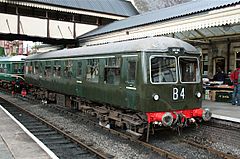British Rail Class 129 facts for kids
Quick facts for kids British Rail Class 129 |
|
|---|---|
 |
|
| In service | 1955- |
| Manufacturer | Cravens |
| Family name | Parcels |
| Number built | 3 |
| Operator(s) | British Rail |
| Specifications | |
| Car length | 57 ft 6 in |
| Width | 9 ft 3 in |
| Height | 12 ft 9 in |
| Maximum speed | 70 mph (112 km/h) |
| Weight | 30 tons |
The Class 129 was a special type of train called a Diesel Multiple Unit (DMU). These trains were built in 1955 for British Rail, which was the main railway company in Britain at the time. Unlike regular passenger trains, the Class 129s were designed to carry parcels and packages, not people!
Only three of these unique trains were ever made by a company called Cravens. They started working on the railways in 1958.
Contents
What Was the Class 129 Train?
The Class 129 was a type of train that could run on its own, without needing a separate engine to pull it. This is what "Diesel Multiple Unit" means – it has its own diesel engine built right into the carriage. These trains were quite special because they were designed for a very specific job: moving parcels and mail around the country.
Built for Parcels
Imagine a train that's like a big delivery truck on rails! That's what the Class 129 was. It was built specifically for carrying parcels, which are packages and mail. This was similar to another train, the British Rail Class 128, which also handled parcels. Having dedicated trains for parcels helped British Rail move goods quickly and efficiently across its network.
How Many Were Made?
The Class 129 was a very rare train. Only three of them were ever built by the manufacturer, Cravens. They were introduced into service in 1958. Because so few were made, they are quite unique in railway history.
What Happened to Them?
Most trains eventually stop running, and the Class 129s were no exception. However, one of the three units, numbered 55997, had a special second life! It was used for "departmental service," which means it was used by the railway company for its own tasks, like carrying equipment or staff, rather than for its original purpose of moving parcels. This unit was even given a cool name: 'Hydra'.
The front part of the Class 129 trains looked quite similar to another type of train, the British Rail Class 105. This shows how train designs sometimes shared features across different models.
Images for kids


